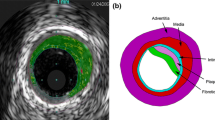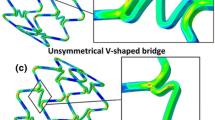Abstract
The biomechanical interaction of stents and the arteries into which they are deployed is a potentially important consideration for long-term success. Adverse arterial reactions to excessive stress and the resulting damage have been linked to the development of restenosis. Complex geometric features often encountered in these procedures can confound treatment. In some cases, it is desirable to deploy a stent across a region in which the diameter decreases significantly over the length of the stent. This study aimed to assess the final arterial diameter and circumferential stress in tapered arteries into which two different stents were deployed (one stiff and one less stiff). The artery wall was assumed to be made of a strain stiffening material subjected to large deformations, with a 10% decrease in diameter over the length of the stent. A commercially available finite element code was employed to solve the contact problem between the two elastic bodies. The stiffer stent dominated over arterial taper, resulting in a nearly constant final diameter along the length of the stent, and very high stresses, particularly at the distal end. The less stiff stent followed more closely the tapered contour of the artery, resulting in lower artery wall stresses. More compliant stents should be considered for tapered artery applications, perhaps even to the exclusion of tapered stents.




Similar content being viewed by others
References
Bedoya J., Stent Design and Arterial Mechanics: Parameterization Tools Using the Finite Element Method, 2005. Department of Biomedical Engineering, Texas A&M University: College Station, TX.
Bedoya J., et al., Effects of stent design parameters on normal artery wall mechanics. J. Biomech. Eng. 128(5):757–765, 2006. doi:10.1115/1.2246236
Berry J.L., et al., Hemodynamics and wall mechanics of a compliance matching stent: in vitro and in vivo analysis. J. Vasc. Inter. Radiol. 13(1):97–105, 2002. doi:10.1016/S1051-0443(07)60015-3
Bosiers M., et al., Carotid artery stenting: which stent for which lesion? Vascular 13(4):205–210, 2005. doi:10.2310/6670.2005.50072
Cheng C.P., et al., In vivo MR angiographic quantification of axial and twisting deformations of the superficial femoral artery resulting from maximum hip and knee flexion. J. Vasc. Interv. Radiol. 17(6):979–987, 2006
Ding Z., M.H. Friedman, Quantification of 3-D coronary arterial motion using clinical biplane cineangiograms. Int. J. Card. Imaging. 16(5):331–346, 2000. doi:10.1023/A:1026590417177
Farb A., et al., Morphological predictors of restenosis after coronary stenting in humans. Circulation 105(25):2974–2980, 2002. doi:10.1161/01.CIR.0000019071.72887.BD
Holzapfel G.A., M. Stadler, C.A. Schulze-Bauer, A layer-specific three-dimensional model for the simulation of balloon angioplasty using magnetic resonance imaging and mechanical testing. Ann. Biomed. Eng. 30(6):753–767, 2002. doi:10.1114/1.1492812
Humphrey, J.D. Cardiovascular Solid Mechanics: Cells, Tissues, and Organs. New York: Springer verlag, 2002
Humphrey J.D., et al., Computer-aided vascular experimentation: a new electromechanical test system. Ann. Biomed. Eng. 21(1):33–43. 1993, doi:10.1007/BF02368162
Indolfi C., et al., Rat carotid artery dilation by PTCA balloon catheter induces neointima formation in presence of IEL rupture. Am. J. Physiol. Heart Circ. Physiol. 283(2):H760–H767, 2002
Kastrati A., et al., Restenosis after coronary placement of various stent types. Am. J. Cardiol. 87(1):34–39, 2001. doi:10.1016/S0002-9149(00)01268-6
Lally C., F. Dolan, P.J. Prendergast, Cardiovascular stent design and vessel stresses: a finite element analysis [erratum appears in J. Biomech. 2006;39(9):1760]. J. Biomech. 38(8):1574–1581, 2005. doi:10.1016/j.jbiomech.2004.07.022
Migliavacca F., et al., Mechanical behavior of coronary stents investigated through the finite element method. J. Biomech. 35(6):803–811, 2002. doi:10.1016/S0021-9290(02)00033-7
Milnor W., Hemodynamics, 2nd ed. Baltimore: Williams & Wilkins, 1989
Rogers C., et al., Balloon-artery interactions during stent placement: a finite element analysis approach to pressure, compliance, and stent design as contributors to vascular injury. Circ. Res. 84(4):378–383, 1999
Rosamond W., et al., Heart disease and stroke statistics–2007 update: a report from the American Heart Association Statistics Committee and Stroke Statistics Subcommittee. Circulation 115(5):e69–171, 2007. doi:10.1161/CIRCULATIONAHA.106.179918
Serruys P.W., N. Kukreja, Late stent thrombosis in drug-eluting stents: return of the ‘VB syndrome’. Nat. Clin. Pract. Cardiovasc. Med.. 3(12):637, 2006. doi:10.1038/ncpcardio0722
Timmins L.H., et al., Stented artery biomechanics and device design optimization. Med. Biol. Eng. Comput. 45(5):505–513, 2007. doi:10.1007/s11517-007-0180-3
Zubaid M., C. Buller, G.B. Mancini, Normal angiographic tapering of the coronary arteries. Can. J. Cardiol. 18(9):973–980, 2002
Acknowledgment
This research was supported by NIH Grant No. R01 EB000115.
Author information
Authors and Affiliations
Corresponding author
Rights and permissions
About this article
Cite this article
Timmins, L.H., Meyer, C.A., Moreno, M.R. et al. Mechanical Modeling of Stents Deployed in Tapered Arteries. Ann Biomed Eng 36, 2042–2050 (2008). https://doi.org/10.1007/s10439-008-9582-0
Received:
Accepted:
Published:
Issue Date:
DOI: https://doi.org/10.1007/s10439-008-9582-0




